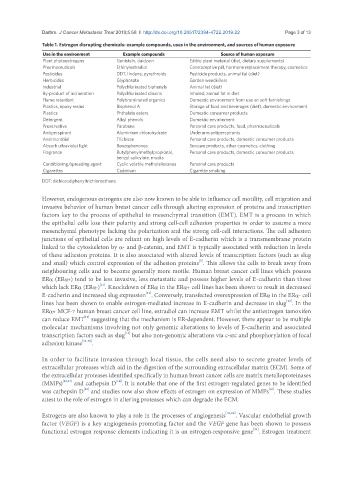Page 390 - Read Online
P. 390
Darbre. J Cancer Metastasis Treat 2019;5:58 I http://dx.doi.org/10.20517/2394-4722.2019.22 Page 3 of 13
Table 1. Estrogen disrupting chemicals: example compounds, uses in the environment, and sources of human exposure
Use in the environment Example compounds Source of human exposure
Plant phytoestrogens Genistein, daidzein Edible plant material (diet, dietary supplements)
Pharmaceuticals Ethinylestradiol Contraceptive pill, hormone replacement therapy, cosmetics
Pesticides DDT, lindane, pyrethroids Pesticide products, animal fat (diet)
Herbicides Glyphosate Garden weedkillers
Industrial Polychlorinated biphenyls Animal fat (diet)
By-product of incineration Polychlorinated dioxins Inhaled; animal fat in diet
Flame retardant Polybrominated organics Domestic environment from use on soft furnishings
Plastics, epoxy resins Bisphenol A Storage of food and beverages (diet); domestic environment
Plastics Phthalate esters Domestic consumer products
Detergent Alkyl phenols Domestic environment
Preservative Parabens Personal care products, food, pharmaceuticals
Antiperspirant Aluminium chlorohydrate Underarm antiperspirants
Antimicrobial Triclosan Personal care products, domestic consumer products
Absorb ultraviolet light Benzophenones Suncare products, other cosmetics, clothing
Fragrance Butylphenylmethylpropional, Personal care products, domestic consumer products
benzyl salicylate, musks
Conditioning/spreading agent Cyclic volatile methylsiloxanes Personal care products
Cigarettes Cadmium Cigarette smoking
DDT: dichlorodiphenyltrichloroethane
However, endogenous estrogens are also now known to be able to influence cell motility, cell migration and
invasive behavior of human breast cancer cells through altering expression of proteins and transcription
factors key to the process of epithelial to mesenchymal transition (EMT). EMT is a process in which
the epithelial cells lose their polarity and strong cell-cell adhesion properties in order to assume a more
mesenchymal phenotype lacking the polarization and the strong cell-cell interactions. The cell adhesion
junctions of epithelial cells are reliant on high levels of E-cadherin which is a transmembrane protein
linked to the cytoskeleton by a- and b-catenin, and EMT is typically associated with reduction in levels
of these adhesion proteins. It is also associated with altered levels of transcription factors (such as slug
[7]
and snail) which control expression of the adhesion proteins . This allows the cells to break away from
neighbouring cells and to become generally more motile. Human breast cancer cell lines which possess
ERa (ERa+) tend to be less invasive, less metastatic and possess higher levels of E-cadherin than those
[11]
which lack ERa (ERa-) . Knockdown of ERa in the ERa+ cell lines has been shown to result in decreased
[12]
E-cadherin and increased slug expression . Conversely, transfected overexpression of ERa in the ERa- cell
lines has been shown to enable estrogen-mediated increase in E-cadherin and decrease in slug . In the
[12]
ERa+ MCF-7 human breast cancer cell line, estradiol can increase EMT whilst the antiestrogen tamoxifen
can reduce EMT suggesting that the mechanism is ER-dependent. However, there appear to be multiple
[13]
molecular mechanisms involving not only genomic alterations to levels of E-cadherin and associated
[12]
transcription factors such as slug but also non-genomic alterations via c-src and phosphorylation of focal
adhesion kinase [14,15] .
In order to facilitate invasion through local tissue, the cells need also to secrete greater levels of
extracellular proteases which aid in the digestion of the surrounding extracellular matrix (ECM). Some of
the extracellular proteases identified specifically in human breast cancer cells are matrix metalloproteinases
[18]
(MMPs) [16,17] and cathepsin D . It is notable that one of the first estrogen-regulated genes to be identified
[16]
[19]
was cathepsin D and studies now also show effects of estrogen on expression of MMPs . These studies
attest to the role of estrogen in altering proteases which can degrade the ECM.
Estrogens are also known to play a role in the processes of angiogenesis [10,20] . Vascular endothelial growth
factor (VEGF) is a key angiogenesis promoting factor and the VEGF gene has been shown to possess
functional estrogen response elements indicating it is an estrogen-responsive gene . Estrogen treatment
[21]

